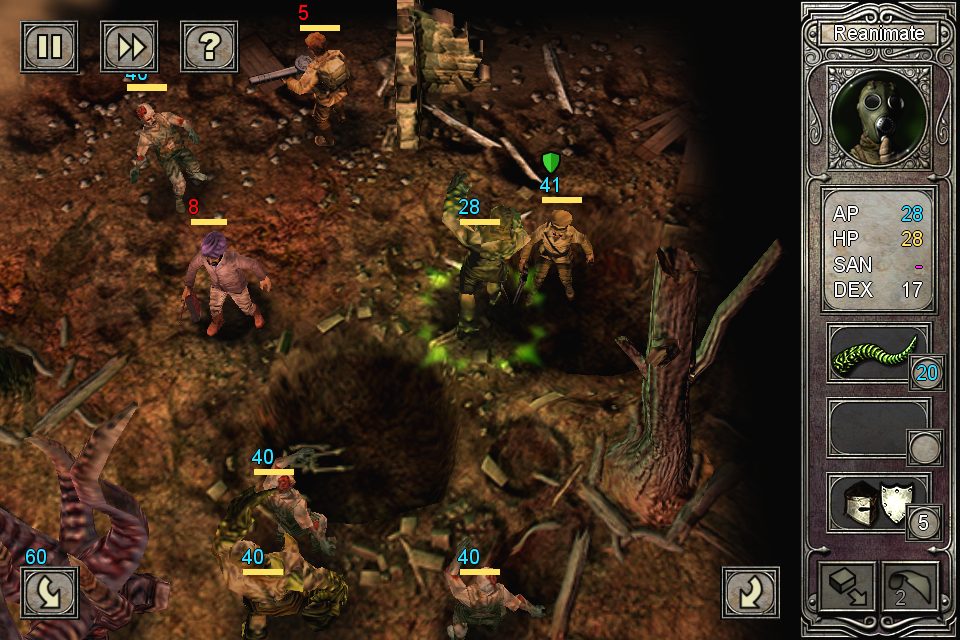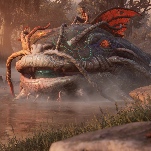Call of Cthulhu: The Wasted Land (iOS)

The First World War demonstrated humanity’s capacity for self-destruction on a scale never before seen. The introduction of aerial combat, trench warfare, and chemical weapons, among other cruel innovations, contributed to a death toll that topped 15 million and left much of Europe an utterly devastated wasteland.
It’s fitting, then, that this grim setting should figure prominently in a game about unimaginable horrors. Rookie studio Red Wasp Design’s iOS release Call of Cthulhu: The Wasted Land is the latest videogame foray into H.P. Lovecraft’s Cthulhu mythos. Primarily a turn-based strategy game, The Wasted Land grew out of lead designer Tomas Rawlings’ work for Chaosium, publishers of the tabletop Call of Cthulhu RPG, and adapts some of that game’s systems. In both its mechanics and its aesthetics, The Wasted Land demonstrates keen reverence for the source material. Yet like Lovecraft’s work itself, it’s an uneven effort that oozes style and promise, but doesn’t fare as well under scrutiny.
The Wasted Land’s plot is adapted from one of the tales in Lovecraft’s series of Herbert West: Reanimator stories. Here, a German villain stands in for Dr. West, the American mad scientist who travels to WWI Europe for the endless supply of fresh corpses it provides for his insidious experiments. A group of intrepid British investigators, guided by occult expert Dr. Brightmeer, is charged with rooting out the German cult and dispatching the ancient horrors it has unleashed in the trenches. The player manages the Allied team, who are enjoyably characterized through in-mission dialogue text.
Character animations are impressively rendered, but even more striking are the maps, which fairly reek with the stench of corruption. Clouds of toxic gas billow over the muck of the blasted no-man’s-land between trenches and razor wire. The Cyclopean monsters you fight are appropriately icky, waving sickly green tentacles and emitting squishing sounds when they move. Like Lovecraft, Red Wasp understands the importance of atmosphere in horror.

Gameplay follows a familiar genre pattern. Units are granted Action Points each turn, which you can spend on a combination of movement, item use, and attacking. Preserving some points allows a character to employ Overwatch, a guard mode that lets him take a potshot at an approaching enemy on the enemy’s turn. More interesting is how The Wasted Land adapts the tabletop RPG’s Sanity system. Each investigator’s Sanity rating shrinks when getting hit by or shooting at a monster, or when casting a spell. At Sanity 0, your investigator will either freeze in fear, unable to act, or enter a manic state, granting you bonus Action Points for a turn until the unit collapses. In one of the most goofily endearing mechanics in recent memory, Sanity can be restored by another investigator “using” one of Freud’s psychoanalysis books on the panicking character.
Between missions, you can upgrade your investigators and their equipment with XP and cash earned from combat, although precisely how those stats are earned is unclear. No matter how much you upgrade your team, though, you always feel underpowered—which makes for tense and enjoyable encounters. Feeling overwhelmed in the face of eldritch horrors from beyond the stars is only appropriate for a Cthulhu game. But The Wasted Lands suffers from balance issues that often make it feel more frustrating than challenging.
-

-

-

-

-

-

-

-

-

-

-

-

-

-

-

-

-

-

-

-

-

-

-

-

-

-

-

-

-

-

-

-

-

-

-

-

-

-

-

-








































